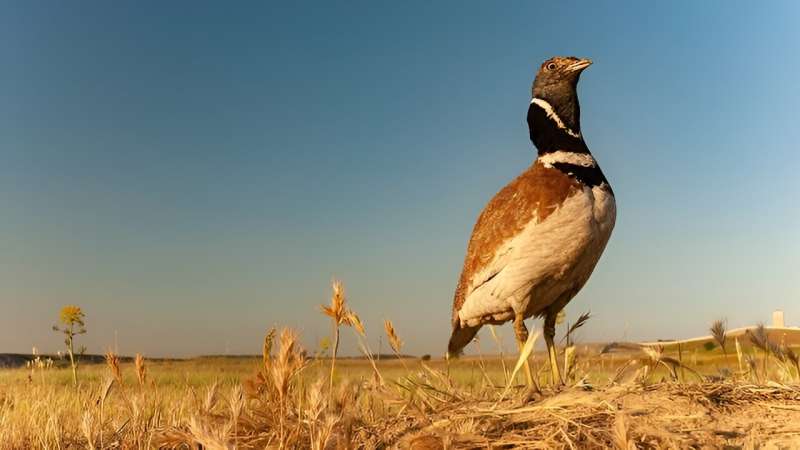This article has been reviewed according to Science X's editorial process and policies. Editors have highlighted the following attributes while ensuring the content's credibility:
fact-checked
peer-reviewed publication
trusted source
proofread
Scientists, farmers, managers work together to avoid the decline of the little bustard

Collaboration between scientists, farmers and managers is crucial to improve the protection of the little bustard, an steppe-land bird in Spain endangered due to human activity. The reduction of natural habitats, the increase in irrigation and the urbanization of the land have led to fewer areas that guarantee the survival of this vulnerable species.
An article published in Biological Conservation reveals how cooperation between different actors is key to finding answers and avoiding the decline of the most threatened populations of the little bustard.
The study, a pioneering example of adaptative conservation, is authored by experts Santi Mañosa, from the Faculty of Biology and the Biodiversity Research Institute (IRBio) of the University of Barcelona, and Gerard Bota, from the Conservation Biology Group of the Forest Science and Technology Center of Catalonia (CTFC).
An endangered steppe-land bird
For birds such as the little bustard (Tetrax tetrax), it is becoming increasingly hard to find suitable habitats due to the reduction of steppe-land and the disappearance of traditional agriculture and livestock farming. The study states that growing the area of fallow lands—the unsown farmland—helps to stabilize the population of the little bustard in Catalonia.
"This strategy has a positive impact on the little bustard, mainly because it increases the reproductive success, for it provides the species with everything that has disappeared in the rain-fed agricultural environments as a result of the intensification of agricultural practices," notes Professor Santi Mañosa, from the UB's Department of Evolutionary Biology, Ecology and Environmental Sciences.
"In spring,—he continues—they find food, places for the males to stop and attract females, mate, nest and feed the baby birds. In summer and autumn, and a great part of the winter, when crops are reaped and cultivated, fallow lands are the only places with enough plants to provide the little bustard flocks shelter and food."
However, fallow lands have lost popularity from a productive and agricultural perspective, and they are in regression in Spain. "Between 2009 and 2018, 21% of the fallow land surface has been lost in Catalonia, according to the latest State of Nature in Catalonia report, published in 2020, and steppe-land bird populations have reduced by 27% between 2002 and 2019, mainly due the loss of fallow lands (as one of the main causes)", notes expert Gerard Bota.
"The little bustard is one of the most affected birds and one of the few species to have suffered a major decline in Catalonia and other areas of Spain in a short period of time. As a result of this situation, it is currently catalogued as an endangered species in Spain, the same level of threat of other emblematic species such as the bearded vulture, the brown bear or the Iberian lynx."
What to do besides promoting fallow lands
The population models generated in this study show that increasing the surface area of fallow lands could certainly halt the decline of the species towards its disappearance, "but this measure, albeit essential, is not enough to recover the population numbers, since adult mortality—particularly in females—is still excessive," warns Santi Mañosa.
"It will be essential to implement other conservation measures that have not been worked on much to date," notes Gerard Bota. "For instance, reducing the mortality of adult females, mainly anthropogenic, which is the one we can manage. We know the little bustard is sensitive to death by collision with power lines because of its relatively reduced frontal vision when flying.
"It would be necessary to identify the main areas of post-breeding and winter aggregation and to act on the power lines installed to reduce the probability of death of the specimens. In the most important breeding and hibernation areas, some lines should be buried or eliminated, and in the rest of the areas, the lines should be properly marked with anti-collision elements."
Generating trust and cooperation among different sectors
In 2009, a total of eight Special Protection Areas for Birds (SPAs) were declared in the steppe sectors of the Lleida Plain, aiming to protect the most important population of little bustard. Over an area of 47,360 hectares, the land use is regulated so that, in theory, the populations of steppe birds can be maintained. "In these areas, the most important measure that has been carried out so far to favor the populations of little bustards has been to lease and manage up to 3,400 hectares of fallow land, where the little bustards can find refuge and food to breed and spend the winter," says Mañosa.
Building trust and cooperation between different sectors related to land and biodiversity conservation is the cornerstone for finding solutions to ecological challenges in increasingly complex systems.
"Adaptive management is an effective process that managers can use to incorporate uncertainty of outcomes into the management model, learn from their actions and achieve the desired results. A key step in this process is the rigorous monitoring and evaluation of management interventions. For this, the work in the same direction of different actors involved in the implementation—Department of Climate Action and Rural Agenda, public companies, managers and scientists—has been key to the success of the measure," says Bota.
This model of adaptive conservation, "which involves the management of complex socio-ecological systems with the interests of very different groups, is exportable to other scenarios that require the application of actions—with an unknown or uncertain outcome—with the participation of very diverse actors," concludes Mañosa.
More information: Santi Mañosa et al, Modelling the effectivity of a land sparing strategy to preserve an endangered steppe-land bird population in cereal farmland: Scopes and limits, Biological Conservation (2023). DOI: 10.1016/j.biocon.2023.110386
Journal information: Biological Conservation
Provided by University of Barcelona




















